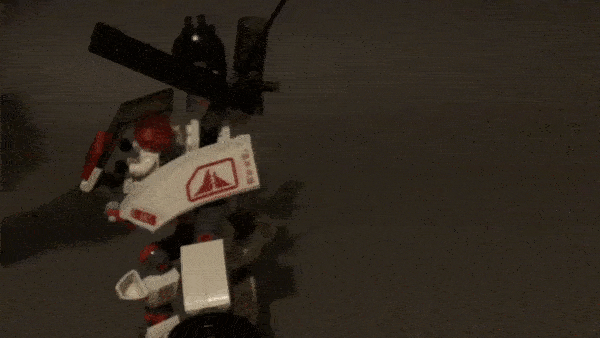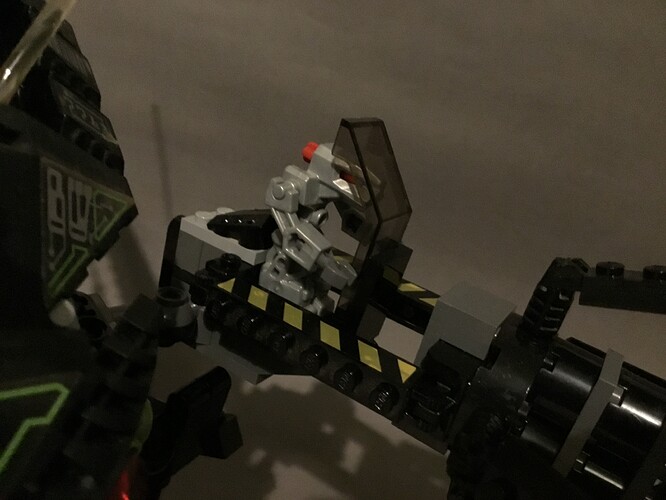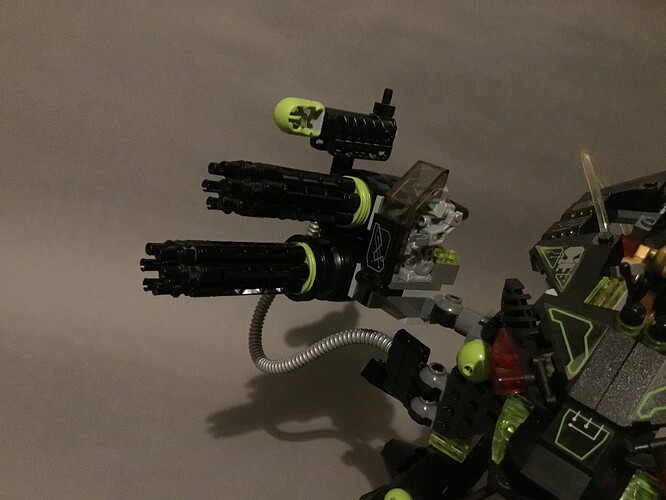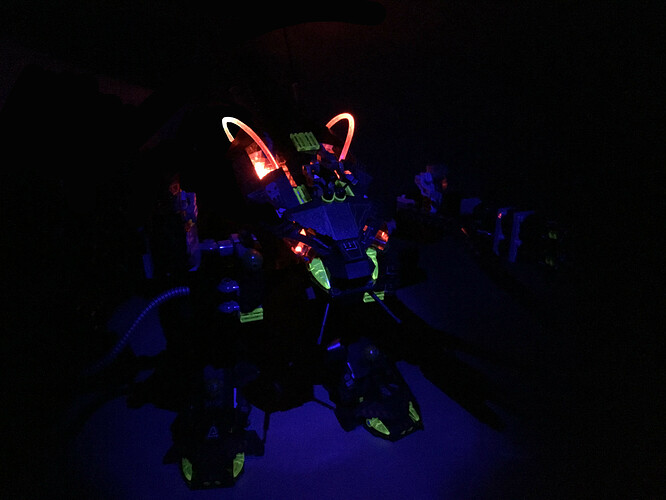I’m back yet again with another Exo-Force review, this time of the highly coveted Bridge Walker vs White Lightning.
Disclaimer: This review is a lot longer than usual.
The background of this set and why it’s become so sought-after is an interesting one, but that’ll be explored at the end of the review. For now, we’ll just focus on the four included figures.
We once again receive Meca One, this time featuring eyes as he is no longer integrated into his mechanised creation, physically operating it with manual controls.
He’s accompanied by a pair of plain silver Devastators, figures that were exclusive to this set in the 2006 lineup. They would be rereleased later on in the theme’s lifetime, but in the first year this was surprisingly the only way to acquire them. Their lack of coloured markings indicates they have no specialist training, simply basic free-thinking infantry.
Our single human character is Ha-Ya-To, who we can see is clearly reusing Hikaru’s torso and legs. This makes sense, as he too is part of Exo-Force’s air division, wearing an identical stock flight suit. His head and hair is unique, however, with the hair being a red recolour of Ryo’s. His head displays a confident expression as opposed to the usual ‘neutral’ face, while the other side…
…displays an excited, almost cocky expression, again differentiating him from his peers.
Ha-Ya-To pilots the White Lightning, his second machine after the much smaller Gate Defender seen in 7705 Gate Assault. You may be wondering “why is it in such a stunted pose compared to every other mech you’ve reviewed?”. Well, uh, we’ll get to that.
The legs of the machine are fairly standard, with similar details to previous mechs, including Ha-Ya-To’s symbol and some Japanese text. While this text usually says something unique and interesting, this one just translates to ‘White Lightning’. Shocking. There are, however, a pair of Jack Stone engine intakes slapped on either thigh. These intakes are completely loose and just flop around in any pose you put this thing in, really an inconvenience to the design. Worse still, they are the only method of propulsion for what’s supposed to be an airborne mech, appearing pathetically tiny for such a load.
The feet are a unique design, incorporating something previous mechs have lacked: heels! Surely such an innovation greatly improves the stability and poseability of the mech, right?
Apparently not, as the designer made the stupid, stupid decision of attaching the heels to the ankle pivot. This means that whenever you use said pivot, the heel moves below the foot itself and clips whatever surface you have the mech stood upon. This means that the only stable pose you can ever have the legs in is completely straight, with no outwards movement whatsoever.
Regrettably, it only gets worse from here. The machine includes a piece of articulation that previous mechs have missed: a waist swivel! While usually this would greatly improve the poseability of the design, the mech is so absurdly top heavy that it renders the joint practically useless, now acting as some deranged helicopter:

The swivel is so ludicrously loose that with a single push of the figure’s arm, you can spin the entire torso around several times.
The arms of the machine are both just extremely giant six-barrelled guns, which sound fun to pose but are actually a pain because the only articulation is at the shoulder and literally nowhere else. Another disk launcher resides nearby, this time filled with green disks. A sticker is placed on the magazine, a rather poor design choice as the sticker constantly peels at the corners due to being applied to a curved, uneven surface. Worse yet, as opposed to being attached to the shoulder, the launcher is pegged to the arm itself, meaning not only can you not bring the arm down as all the disks would fall out, but it also causes the ammo to fly out of the top every time you move the arm because the shoulder is a jerky ratchet joint!
This is an actual, non-staged picture of what happened when I tried moving the arm up for a pose. That’s right, half the entire ammo load ejected itself from the launcher. Have fun finding them after they fly all over the room. I was lucky that they all just ricocheted off the backdrop.
Just as you think things can’t get any worse, we come to the torso. First of all, this odd, bulbous design makes the machine both front-heavy and top-heavy, making for extremely limited posing options. Worse still, the stickers on either shoulder don’t even correspond with each other.
The right shoulder sports a big ‘A.03’. This matches the other air vehicles Stealth Hunter and Gate Defender, A.01 and A.02 respectively. However, for some reason, the other shoulder has the Ground Force symbol! And, as if to make matters worse, it even says ‘Ground Unit’ in Japanese next to the incorrect logo, making even the stickers of this horrendous model botched.
But that doesn’t even compare to how breakable this area is. First off, the waist. The area you’re most inclined to pick the mech up by. The crotch plates aren’t connected at the back, so squeezing them too hard pops them right off.
The cockpit is similarly fragile, only connected by a single piece and not even secured on the reverse side!
And, finally, the shoulders. These massive plates are both attached by only a single tiny clip. This obviously causes them to detach with the slightest touch.

Apparently Lego knew how poorly designed this abomination was, so they decided to market its fragility as a function. “Hey, look kids, I break super easily! Buy me!” It’s obvious this wasn’t the original intent, as these pieces would otherwise be easier to shoot off. The force of a projectile hitting them doesn’t make them detach, it’s the force of someone trying to hold the mech. Force from the sides, not the front.
But we’re not done with this abysmal vehicle just yet. Atop the cockpit is a dual staircase cannon, topped with a laughably long antenna that, as you may have guessed, breaks off easily.
This machine is an appalling, ugly, fragile mess that tests my patience in more ways than one. Let’s see if it’s adversary can fare any better.
Comparatively, the Bridge Walker is a huge, bulky and imposing creation that demands attention in most displays. It’s surprisingly robust, with every section properly secured in multiple places with strong technic constructions.
Size-wise it’s not much taller than a standard Bionicle titan, but it feels bigger simply by how incredibly thick every segment is.
Starting at the feet, we can immediately notice just how big every area is compared to a minifigure. It’s truly a sight to behold. Each foot is approximately 10 (!) studs wide, decorated with some Bohrok eye claws and danger stripes which add striking colour to the mech.
The ankle is fully encased in an angular black armour, protecting the leg from every angle. Two huge cones extend from each side, indicating a joint in the section, while a bright green dome breaks up the monotonous black.
This machine is one of the few in Lego as a whole to use the ‘chicken-leg’ digitigrade design, which this mech uses very successfully. Two huge spikes jut out from the ‘knee’, covered in some trans-green lights. This leads into the thigh section, similarly bulky and well-armoured.
Sadly, this is one of the few flaws with this monstrous machine: there’s no articulation in the legs whatsoever. Kind of ironic for something called the Bridge Walker. However, it’s not as big an issue as you’d think.

Luckily, due to their technic frame, the legs can be easily flexed and therefore moved in an extremely satisfying stomping movement (seriously, if you have this set and try doing it you’ll be stuck doing it for ages), so motion can still be achieved. Really, this is only an issue for display, as the legs must remain static. I understand why it’s been done though; without such a robust structure, this machine could be prone to breaking apart, something you don’t want to hear for such a large and heavy model.
The left arm carries an impressive pair of machine guns, an exact replica of the one found on the small Sentry. This further adds to the idea of the robots mass-producing their weaponry. Four hinged shields are attached on each side, adding some great shaping. I’d imagine they splay out as the guns fire and collapse in after.
This emplacement is big enough to have an entire dedicated gunner’s seat, with a protective windshield in front of the Devastator operator.
The other arm sports an even more colossal pair of rotating six-barrelled staircase guns for ravaging Exo-Force’s defences. A silver hose stretches from the side of this array to the hip of the machine,presumably for providing ammunition. A single redesigned competition cannon resides on top, able to launch a powerful rubber-tipped rocket great distances.
Another gunner operates the weapons on this side, accompanied by two pointed tips extending from the backs of the guns, which can be spun by hand to recreate a shooting motion.
The mech’s torso is remarkably small, and its slim nature may suggest fragility. However, like the legs, it is remarkably sturdy, able to support immense weight with ease.
The Bridge Walker is, surprisingly, the only humanoid mech in the entire theme to actually have a head. The head displayed here is very alien in nature, almost Xenomorph-inspired with the long, trailing section extending from the back. In terms of articulation, the head can swivel around and can be ratcheted down on a hinge joint.
The facial area is very well-designed, using a multitude of Bionicle pieces. Bohrok eyes represent both eyes and a pair of fangs, while Visorak feet frame the eyes and provide superb texture. A pair of spearguns representing another set of guns protrude from the chin, allowing this mechanised monstrosity to mow down any infantry the Exo-Force may send as opposition.
Meca One drives the machine, requiring only a pair of levers. I suppose one for each leg.
Up top, we find a large slope with an identical design to Striking Venom’s leg patterns, alongside pair of antennae which match the Sonic Phantom. While these are built exactly the same as the White Lightning’s fragile antenna, their secluded placement makes them a lot less prone to breaking off.
Additionally, two fibre optic cables extend out from behind the head and snake through some gaps in the angled side panels to plug inside the red Bohrok eyes. Each cable is connected to a separate light brick on the sides of the head, which of course means…
Upon squeezing both sides of the head, the cables and eyes light up ferociously. I’m just going to say right now that this is my favourite use of the light brick gimmick in any Exo-Force set. It’s such a cool feature and is the only set ever to utilise the seemingly useless bar connection inside the Bohrok eye’s centre. In addition, the light emitted by the brick itself illuminates some trans-red cylinders placed directly above them in the side panels’ gaps.
Also, this model looks downright ethereal under a blacklight. All the green areas shine beautifully, the only thing missing is the eyes.
Of course, you could always just activate the light bricks manually, but for an automatic glow under a blacklight I’d recommend switching the red eyes out for neon orange ones, the only other UV-affected transparent Lego colour.
That’s it for the actual set, but now for some background information.
This set originally retailed for £34.99, the exact same price as Striking Venom. This represents great value, but you’ve got to think: you’re basically paying £10 for the White Lightning and £25 for the walker. Again, good value, but the White Lightning is so insanely horrible that it really drags the set down. It seems like an afterthought that was quickly slapped together to bring the price up. It’s a really unnecessary inclusion to what could’ve been a phenomenal set. Though, even without the White Lightning, I feel the Bridge Walker itself is large, imposing and impressive enough to still be worth the full £35 price on its own, an excellent price for an excellent model.
However, that’s where aftermarket value comes in. To start with, the set was marketed as a ‘Special Edition’ product in America, as seen here:

This meant that, while the set was available at regular retail, it was harder to come across at was available for a more limited period of time.
However, internationally, this ‘Special Edition’ branding was nowhere to be seen. Strangely, the box was bigger too:
You may be wondering why this box seems to be wrapped in cling-film. Well, that’s the thing. While, in America, the set was marketed as a limited release but could be found at regular retail, the international version was a Lego exclusive, meaning you could only find it at Lego stores, which there weren’t that many of at the time, or the Lego website, which was still in its early stages of development and wasn’t as intuitive to use.
This meant that while many copies were manufactured, they were very hard to get ahold of, and as such the set now demands a exorbitantly high price of over four times the original price. The set is currently valued at an astonishing £155 used, making it the single most expensive Exo-Force set on the secondary market, easily surpassing even giants like Sentai Fortress!
This increased price completely demolishes any sense of value the original price had. 657 pieces for £155? Suddenly that price-per-piece doesn’t look so great. If you divide that price by the basic ratio we calculated before, you’re paying about £110 for the Bridge Walker and £45 for the White Lightning. £110 for the walker isn’t actually too outrageous, price-per-piece wise it’s abysmal but the finished model easily surpasses similarly priced modern sets in size. £45 for the White Lightning, though? Ouch. There is no way that such a horrific, breakable, abhorrent mess as the White Lightning would ever be worth such a price, and as such it makes the current value look really atrocious. I suppose you could justify it as being £155 for the walker and the White Lightning is just a free extra, but even then, I wouldn’t say the walker’s worth that much.
Score-wise, the Bridge Walker gets a clean sweep, a full 10/10. The only fault I can find with such an impressive and beautiful model is the lack of leg articulation, but even then I understand the reasoning and it’s not as obtrusive as you’d think.
The White Lightning on the other hand…, Never in my life have I seen such a flimsy, unstable, poorly designed, hideous, unsightly, gappy, unfinished, dreadful model put out for retail from Lego. It’s honestly astounding how this was deemed worthy to be released. It doesn’t just look like a turd, it poses like one as well, and is liable to crumble if you so much as pick it up. 1/10. And that’s being generous.
So, as a whole? I’m sorry, but I can only give the set a 8/10. It’s still good, but the White Lightning is just so astutely, horrifyingly appalling that I can’t bring myself to give it a full score. Combined with the ludicrously high current value, I can only really recommend this if you can find it cheap like I did.
However, if (and that’s a big if) you really want it, the £155 price isn’t ridiculously bad for the walker. It’s truly a breathtaking, elegant model that surpasses even the Striking Venom in its stunning appearance. It’s certainly not a price for everyone, but I feel it could theoretically be justified.
Next time we’ll cap off Exo-Force’s first year with a look at the largest set of the theme…






































